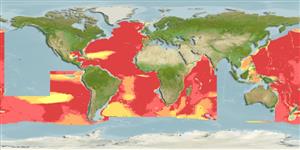>
Beryciformes (Sawbellies) >
Cetomimidae (Flabby whalefishes)
Etymology: Cetomimus: Greek, ketos = a marine monster, whale + Greek, mimos, ou = imitator (Ref. 45335).
More on authors: Goode & Bean.
Environment: milieu / climate zone / depth range / distribution range
Ökologie
seewasser bathypelagisch; tiefenbereich 750 - 2300 m (Ref. 6532). Deep-water
Eastern Atlantic: only one specimen was reported from the Gulf of Guinea. Elsewhere, reported from the northwest Atlantic, Indian, central and southeast Pacific oceans.
Size / Gewicht / Alter
Maturity: Lm ? range ? - ? cm
Max length : 11.2 cm SL Männchen/unbestimmt; (Ref. 6532)
Life cycle and mating behavior
Geschlechtsreife | Fortpflanzung | Ablaichen | Eier | Fecundity | Larven
Paxton, J.R. and D.J. Blake, 1990. Cetomimidae. p. 607-608. In J.C. Quero, J.C. Hureau, C. Karrer, A. Post and L. Saldanha (eds.) Check-list of the fishes of the eastern tropical Atlantic (CLOFETA). JNICT, Lisbon; SEI, Paris; and UNESCO, Parisl. Vol. 2. (Ref. 6532)
IUCN Rote Liste Status (Ref. 130435)
Bedrohung für Menschen
Harmless
Nutzung durch Menschen
Fischereien: nicht kommerziell
Mehr Information
NamenSynonymeMetabolismusRäuberÖkotoxikologieFortpflanzungGeschlechtsreifeAblaichenSpawning aggregationFecundityEierEientwicklung
Alter/Größe
Wachstum
Länge-Gewicht
Länge-Länge
Längenhäufigkeiten
Morphometrie
Morphologie
Larven
Larven Pop.Dyn.
Rekrutierung
Dichte
BRUVS
ReferenzenAquakulturAquakultur ProfilZuchtlinienGenetikElectrophoresesVererbbarkeitKrankheitenVerarbeitungNutrientsMass conversion
PartnerBilderStamps, Coins Misc.LauteCiguateraGeschwindigkeitSchwimmstilKiemenoberflächeOtolithsGehirngrößeSehfähigkeit
Tools
Zusatzinformationen
Download XML
Internet Quellen
Estimates based on models
Preferred temperature (Ref.
123201): 2.2 - 6.1, mean 4.7 °C (based on 402 cells).
Phylogenetic diversity index (Ref.
82804): PD
50 = 0.5078 [Uniqueness, from 0.5 = low to 2.0 = high].
Bayesian length-weight: a=0.00389 (0.00180 - 0.00842), b=3.12 (2.94 - 3.30), in cm total length, based on all LWR estimates for this body shape (Ref.
93245).
Widerstandsfähigkeit (Ref.
120179): hoch, Verdopplung der Population dauert weniger als 15 Monate. (Preliminary K or Fecundity.).
Fishing Vulnerability (Ref.
59153): Low vulnerability (10 of 100).
